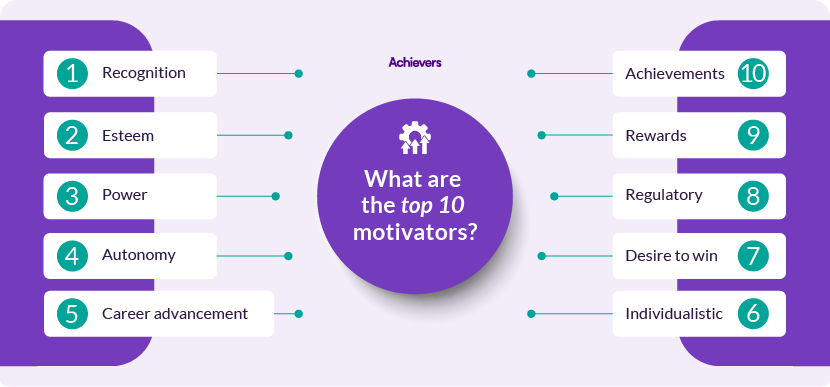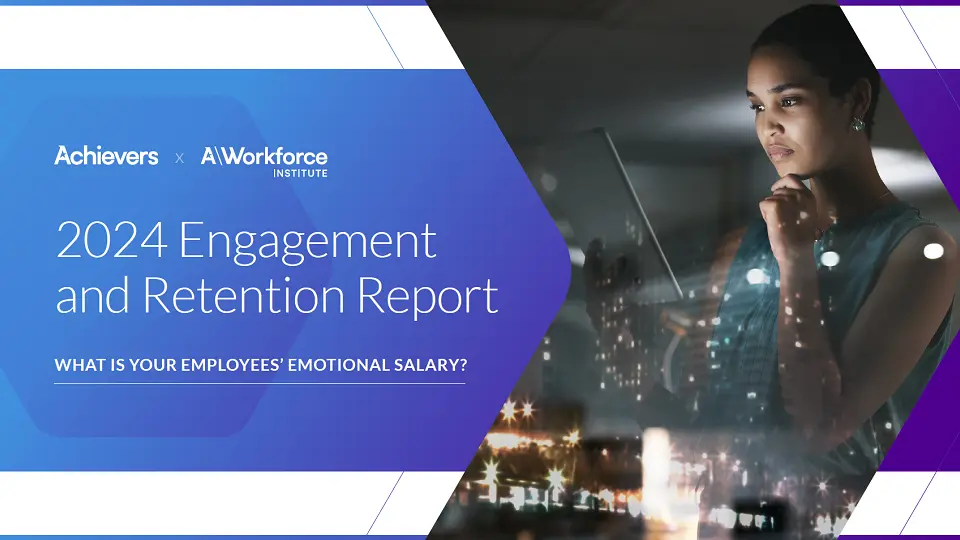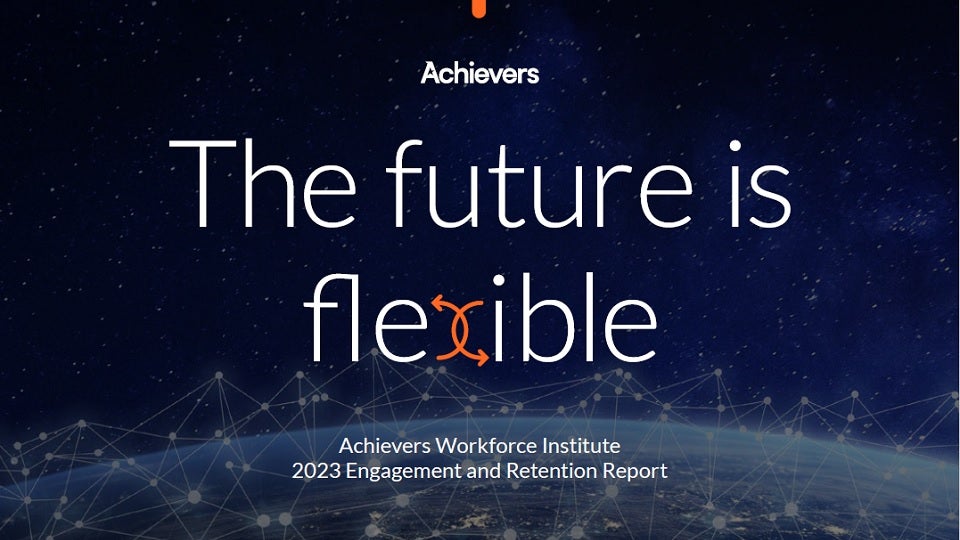Table of contents
New generations entering the workforce have unique perspectives and expectations about meaningful work and motivating rewards. Savvy employers understand the difference between intrinsic and extrinsic motivators and develop engagement programs that recognize and reward employees for exercising the right behaviors and aligning with company goals.
A motivated employee is more likely to go beyond minimum work expectations, deliver high-quality work, and seek out new challenges. Motivation is a quality that energizes and guides behavior, and each of your employees has different motivators:
What are extrinsic motivators?
Extrinsic motivators are external rewards that encourage people to perform or complete certain tasks. This type of motivation can be either tangible or intangible. Tangible rewards are most common in the form of financial incentives, such as salary or bonuses, while recognition, praise, and promotion are examples of intangible rewards.
What are the pros and cons of extrinsic motivation?
The effects of extrinsic motivation vary from strengthening positive behavioral changes to boosting employee productivity, extrinsic motivation also can also have its own drawbacks if being used excessively.
Pros of extrinsic motivation
1. Increase productivity
External rewards or incentives motivate employees to put in their best effort and produce high quality outcomes. When employees work on a specific task that can earn them rewards for completion, they are more motivated to focus, meet deadlines, and reach their goals for the project. Extrinsic motivation can also get workers to participate in tasks that are out of their interests or comfort zone, thus encouraging them to adopt new skills and knowledge at work.
2. Promote effective teamwork
One crucial and intangible extrinsic motivator is positive relationships at work. In a healthy workplace environment, positive relationships mean respect, clear communication, and frequent recognition and appreciation. These factors are examples of extrinsic motivators that can help develop cohesion and efficient collaboration among team members while creating a supportive space for employees to ask for help and feedback.
3. Maintain job satisfaction
Extrinsic factors like recognition and praise from managers can significantly promote employees’ overall job satisfaction. 2023 research from McKinsey shows that manager-employee relationships account for 86 percent of employees’ job satisfaction. While manager effectiveness is a major factor in nurturing positive relationships with employees, our 2023 AWI research finds that only 29% of managers say their company supports them to be a better people leader. With recognition being one of the main factors that can help improve their relationships with employees, this extrinsic motivator can greatly promote employees’ engagement, sense of belonging, and satisfaction at work.
4. Boost employee retention
According to Gallup’s 2023 State of Global Workplace report, 51% of employees are either passive or active job hunting with increased pay being the top factor that they want in their next job. Financial rewards and bonuses can help employees feel valued for the work they do and are effective in driving short-term goals and performance. However, more meaningful and long-term extrinsic motivators, such as promotion or frequent recognition, will better strengthen employee loyalty and commitment to their companies.
Finding the right talent for your company is not easy, with the right combination of extrinsic and intrinsic motivators, your company is closer to achieving organizational goals.
Cons of extrinsic motivation
Employees who are extrinsically motivated may only work for a financial reward or to reach certain performance targets set by their managers. External rewards, such as bonuses can also cause a shift of focus away from the task and onto the outcome, hindering productivity and creating unnecessary competition among employees. Employees, then, can experience a reduced sense of enjoyment in tasks that were previously intrinsically fulfilling. This means that while extrinsic rewards can help improve short-term performance, they may not be meaningful or sustainable for an organization in the long run. This is when intrinsic motivation comes into play and creates the balance to help employers tap into employees’ best potential.
What are intrinsic motivators?
Intrinsic motivators are internal incentives that arise from within an individual and are most often driven by personal values and fulfillment. Employees who are motivated by intrinsic rewards complete work because it is personally rewarding. These are psychological motivators, and they typically fall into four reward categories: meaningfulness, choice, competence, and progress.
What are the pros and cons of intrinsic motivation?
Unlike extrinsic motivation, which relies on incentives and external rewards, intrinsic motivation is more sustainable as it cultivates continuing engagement, creativity, and satisfaction in employees. At work, intrinsically motivated employees are driven by their inherent values and overall sense of purpose. They are more likely to enjoy the process and less likely to focus on rewards for their outcome.
Pros of intrinsic motivation
1. Create a sense of purpose
When Gartner identifies major changes in the workplace in the next 10 years, employees’ passion and sense of purpose is one of them. Employees are actively seeking opportunities where they can tie the impact of their work to their mission and inner values. With intrinsic motivation, employees can see meaning behind the work that they do and feel a stronger sense of belonging with their companies.
2. Nurture personal fulfillment
When employees have an opportunity do something simply because they want to learn and grow, those moments are highly empowering. For example, Achievers defines emotional salary as the non-monetary components that contribute to an employee feeling adequately rewarded at work. While emotional salary can be an extrinsic motivator, such as recognition from peers and managers, it is also intrinsic as it is closely connected to personal fulfillment and job satisfaction.
3. The buffer against burnout
We spend one-third of our lives at work, and with rising concerns about stress and burnout, 68% of senior HR leaders are putting employee well-being as their top priority. Intrinsic motivation helps employees find meaning and impact in their work and nourish a positive mental outlook during hard times. Managers should also help their employees identify intrinsic motivators that are specific to their goals and needs to maintain a healthy work-life balance.
4. The domino effect
When one person wins, the whole team wins. Intrinsic motivation is not only personally rewarding, but it also helps foster a healthy environment with high quality relationships at work. Employees who are intrinsically motivated by their interest and satisfaction can meaningfully inspire others and contribute to a company culture driven by core values and personal fulfillment.
Cons of intrinsic motivation
The positive influence of intrinsic motivation on employees are loud and clear; however, this type of motivation is intangible and can be challenging to quantify: how much of intrinsic motivation does an employee require to be fulfilled and successful in their work? In many cases, an intrinsic reward does not suffice, and employees must be rewarded in other ways to help them feel cared for by the company.
You need to understand the different sources of employee motivation so that you can train managers to match the right rewards and recognition styles to the right employee. If you don’t understand what motivates the multigenerational workforce, you might start losing talent. As the economy picks up, many workers are no longer satisfied staying in jobs that don’t feel rewarding most of the time.

What are the top 10 intrinsic and extrinsic motivators?
1. Rewards
Rewards can be either extrinsic or intrinsic depending on different types. While extrinsic rewards can be financial incentives or public recognition, intrinsic rewards include a sense of purpose, skill development, and personal accomplishment.
2. Recognition
Recognition is an extrinsic motivator. At work, recognition from managers is particularly powerful. A 2024 AWI report finds that people recognized by their managers at least monthly are more likely to regularly recognize others. This snowball effect creates a culture of recognition that empowers employees and keep them engaged.
3. Belonging
A sense of belonging is an intrinsic motivator. The AWI Belonging Blueprint includes 5 pillars: welcomed, known, included, supported, and connected. Employees who are intrinsically motivated by a sense of belonging will seek a company culture where these 5 needs are met.
4. Autonomy
Autonomy is an important intrinsic motivator at work. Employees are more likely to succeed when they feel empowered to make decisions and have control over aspects of their work.
5. Esteem
Esteem is an intrinsic motivator. Everyone wants to be treated with respect at work, and becoming a source of inspiration for others can be one of the major drivers for high performance and success.
6. Individualistic
A sense of individualism is an intrinsic motivator. As much as employees want to work collaboratively with their teammates, they also seek freedom where they can listen to their own voice and work individually.
7. Regulation
Regulation is an extrinsic motivator. Some employees complete a task to satisfy an order and avoid punishment. While regulation can drive productivity and help employees maintain focus, it can also hinder employee creativity and long-term engagement.
8. Career advancement
Career advancement is an intrinsic motivator. An AWI report on engagement and retention finds that career progression is employees’ number one reason to job hunt in 2024. If this is the top reason for job hunt, it is also a crucial factor to stay at a company long term.
9. Achievement
Achievement is an intrinsic motivator. Employees who are intrinsically motivated by achievement seek workplaces where they can see and measure their outcomes.
10. Desire to win
Desire to win is an intrinsic motivator. Some people are more competitive than others, and this motivator can help keep employees curious and engaged.

Motivating at all ages
The workforce is now composed of four generations of employees: Baby Boomers, Generation X, Generation Y (millennials), and Generation Z.
Baby Boomers tend to be more motivated by work-life balance. They are loyal to their organizations and enjoy sharing their knowledge and experience. Baby Boomers often appreciate more traditional rewards, like items with monetary value, and recognition that they are balancing external duties in their personal lives.
Gen Xers typically have a more individualistic perspective about work. People in this group are after the traditional trappings of success, such as promotions, corner offices, and financial benefits that will help them support their families.
Millennials usually appreciate rewards that let them control their work time, enjoy personal activities, and support their passion for charities, the environment, and social causes. They often prioritize work flexibility over salary and monetary rewards. Millennials also tend to crave feedback, so they can be motivated well by pats on the back and public praise.
Gen Z workers are very purpose driven. They actively seek employment opportunities with companies whose values align with their own, and who encourage them to use their voices to enact positive change within the organization. Companies that prioritize diversity, mental health and wellbeing, and transparency are particularly appealing to Gen Z job seekers. It is important to provide them with an engaging work environment that allows them to express their passions and continue to develop professionally.
Developing an impactful reward system
Salary increases and annual bonuses alone are not the answer to raising levels of employee engagement. A review of 120 years of research found a weak link between salary and job satisfaction, and this is still true today according to Forbes. Salary is important at the point of hiring but becomes less important once an employee is on board. Global employers, in particular, are challenged with engaging and motivating a geographically dispersed workforce. How do you:
- Understand and address each employee’s motivators
- Engage the workforce as a whole
- Align workforce performance across the organization
- Develop an impactful and fair reward system that includes both intrinsic and extrinsic incentives

Single platform for multiple results
The answer is found in technology. Reward and recognition platforms (like the Achievers Experience Platform), allow employees to earn a mix of public praise and appreciation (which taps into those intrinsic motivators), as well as redeemable points (which tap into extrinsic, monetary motivators).
When you provide employees with a marketplace of items they can shop for with the points they’ve earned, you’re providing a truly tailored experience for each person. Employees are empowered to select the item that’s most meaningful to them, whether it’s plane tickets for a dream vacation, a designer bag, charitable donations, or a Visa® prepaid card they can use for daily expenses.
Give employees what they want: Extrinsic and intrinsic motivators
The single platform as a reward system has two important advantages. You can collect global performance data at every level of the organization, and employees can pick the rewards that mean the most to them. The rewards are not tied to an employee’s tenure or their status in a hierarchy, like most traditional reward systems.
You can continue to link the remuneration to your employee’s role, but any reward system should be flexible enough to acknowledge extrinsic motivations and the four groups that comprise opportunities for intrinsic motivation. Attract, engage, and align employees, and give them the rewards they want for exhibiting the right behaviors. It’s the formula for a successful employee engagement strategy.
Are you looking for ways to boost employee engagement? Does your leadership team need inspiration for meaningful employees’ extrinsic and intrinsic motivation? Book a demo with Achievers to learn how recognition can build a sustainable and meaningful source of motivation for your employees.





